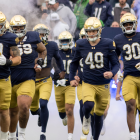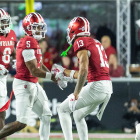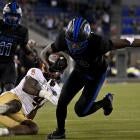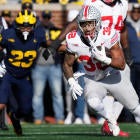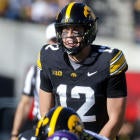The whole idea of the College Football Playoff was to be new, something we haven't seen before.
Certainly, in some ways, it has provided that. A third-team quarterback (Cardale Jones) rose from the depths of the depth chart to lead Ohio State to a crown. A pair of Heisman Trophy winners (Marcus Mariota and Jameis Winston) met in a CFP semifinal (2014 Rose Bowl).
Three of the eight coaches who participated in the first three years of the playoff are either retired (Bob Stoops), looking for work (Mark Helfrich) or moved on to another job (Jimbo Fisher). The Pac-12 has been marginalized (only two CFP berths in four years). The Big 12 is back within the margins (a Heisman and Oklahoma's second CFP berth).
But the overriding theme of the fourth CFP is same old, same old. Welcome to Clemson-Alabama III. The Sugar Bowl semifinal could be either absolutely thrilling or the beginning of something tedious. Depends on your view.
Alabama needed a bold onside kick to beat Clemson and claim its last national title in 2015. The Tigers needed a touchdown with a second to go last January to claim the program's second title, its first since 1981.
This third straight meeting is merely a semifinal in the Sugar Bowl. But this CFP rivalry isn't going away. Until the playoff, the teams had met only 15 times since 1900. Now they're meeting for the third time in two calendar years.
Dynasties are at stake. Alabama is in the middle of one. Clemson appears to be establishing one. In terms of look, feel, talent and budget, the programs are above everyone else at the moment.
The Sugar Bowl winner will not be this year's champion. But it will hold the edge over the other in this best two-out-of-three in this series. And it's unlikely this three-game CFP series will be the end.
"Nothing is going to change where we're going," Clemson coach Dabo Swinney said. "… Winning the national championship has never been the driving force -- ever. It's just a byproduct of what can happen. Hopefully, we'll get it again. If it doesn't work out this year, we'll have another swing at it."
Besides being a $7 billion money grab, at its heart, the CFP was meant to get more noses under the tent: more access, more drama, more teams, more championship diversity.
Uh, no. If Alabama isn't the favorite to win it all (and it is, at least in Las Vegas), that edge goes to top-ranked defending national champion Clemson.
Swinney and Nick Saban have combined to win five of the last eight national championships. If either wins it this season, that will make it six of the last nine.
Sound familiar? It shouldn't. Only once before in the history of the game have teams met in three consecutive postseasons (Ohio State-USC, 1973-75 Rose Bowls). Two legends -- John McKay and Woody Hayes -- squared off in those games. But only once in those three Pasadena meetings was a national championship involved (1973, USC).
For the last three seasons, the road to the national championship as gone through these teams. Clemson-Alabama will account for a quarter of the 12 CFP games by the end of this year's playoff. Will the public embrace it? Low ratings helped expand the bracket when LSU and Alabama met twice during the 2011 season.
The guess here is that folks will be more than interested in an NFL playoffs kind of way. We can't get enough of Patriots-Steelers. Why not Tide-Tigers?
Forget for the moment about the Power Five becoming the Power Four or the SEC's return to dominance. If there is a conclusion to the early years of the CFP, it's that Clemson and Alabama are pulling away from field.
That's not to dismiss Oklahoma and Georgia in the Rose Bowl. Thirteen of the last 14 national champions have finished in the top 20 in total defense. Oklahoma could be that rarity -- winning by outscoring everyone. Its defense is currently 57th nationally in the point-happy Big 12.
Georgia is Alabama Lite. In his second season, Kirby Smart has built a team that runs and stops the run, following the typical SEC playbook. But the Dawgs are also this CFP's Cinderella with Jake Fromm trying to become the first true freshman quarterback to win a national title in 32 years.
Good football is good football, but the CFP has also proved it is an exclusive club. The Bulldogs are only the ninth team to play in the CFP out of the 16 spots available over four years.
But for an indication where college football is headed, pay attention to New Orleans.
- During the first-ever Early Signing Period last week, Clemson and Alabama landed five of the top nine players in the Class of 2018, per 247Sports.
- The senior class at Clemson became the fourth straight to be the winningest in school history.
- You think brand names don't matter? Since 2011, Alabama has lost three times in November and still played for the national title.
- Since the fifth week of the 2015 season, Alabama (36-2) and Clemson (37-3) have the two best records in the country. (Oklahoma is third at 31-5.)
In the BCS era (since 1998), the game was isolated around the Power Six (now Power Five) programs. In the last 10 years, the SEC became the dominant conference winning seven national championships in a row (and eight of the last 11). The game has remained centered in the Southeast. It has been dominated within that region lately by Clemson and Alabama.
One of the few limiting factors for this rivalry is age. Nick Saban is 66. There is a view of his retirement from here. In the SEC West alone, Auburn's Gus Malzahn (seven years) and Texas A&M's Jimbo Fisher (10 years) seemed to sign lengthy new deals with that reality in mind. In other words, they're hoping to still be around when Saban leaves.
Of the four active national championship coaches -- Saban, Fisher and Urban Meyer are the others -- Swinney, 48, is the youngest. Oklahoma's Lincoln Riley, at 34, is the youngest to compete for a national title since at least the start of the BCS era.
If you think this Clemson-Alabama thing is getting old, well, deal with it.
Until someone else breaks through, the Tigers and Tide continue to define college football's postseason.








